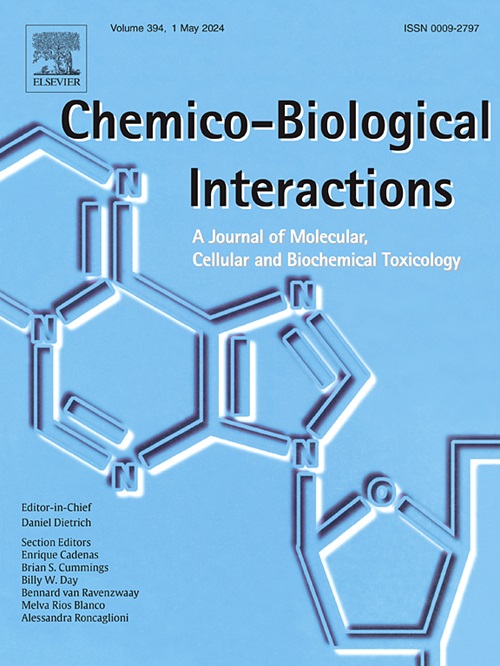Pantothenic acid alleviates osteoarthritis progression by inhibiting inflammatory response and ferroptosis through the SIRT1/Nrf2 signaling pathway
IF 4.7
2区 医学
Q1 BIOCHEMISTRY & MOLECULAR BIOLOGY
引用次数: 0
Abstract
Osteoarthritis (OA) is a degenerative joint disease that is a major cause of deformity, swelling, pain and even loss of function in the knee joints of the elderly. Pantothenic acid (PA) plays a protective role in many organs due to its antioxidant and anti-inflammatory properties. Herein, we aimed to assess the protective role of PA on osteoarthritis and investigate the underlying molecular mechanism. The levels of inflammatory factors (IL-1β and TNF-α) in knee tissues were measured by ELISA. The Safranin O-Fast Green staining was used to assess the severity of OA and the H&E staining was used to assess the degree of synovitis. In vitro, the levels of iron, MDA, GSH were measured by the detection kits. Western blotting was used to assess the levels of signaling-related proteins. Our results showed that PA significantly attenuated the degree of cartilage degeneration in the MIA-induced osteoarthritis model. PA also reduced the expression of IL-1β, TNF-α, MMP1 and MMP3. In vitro, PA effectively reduced the concentrations of MMP1 and MMP3 in IL-1β-stimulated chondrocytes. PA decreased the levels of Fe2+ and MDA, while increasing GSH production and GPX4 and SLC7A11 expression in IL-1β-induced chondrocytes. Meanwhile, we found that PA was able to inhibit the phosphorylation level of p65, IκB protein in chondrocytes, which effectively blocked the NF-κB signaling pathway. Furthermore, PA also increased the level of SIRT1, Nrf2, and HO-1 protein expression. In addition, the inhibition of PA on IL-1β-induced MMPs production and ferroptosis were inhibited by the SIRT1 inhibitor EX-527. In conclusion, PA inhibited chondrocyte ferroptosis and cartilage destruction in osteoarthritis. The mechanism was through activating SIRT1/Nrf2 signaling pathway.
泛酸通过SIRT1/Nrf2信号通路抑制炎症反应和铁下垂,从而缓解骨关节炎的进展
骨关节炎(OA)是一种退行性关节疾病,是老年人膝关节畸形、肿胀、疼痛甚至功能丧失的主要原因。泛酸(PA)由于其抗氧化和抗炎的特性在许多器官中起保护作用。在此,我们旨在评估PA对骨关节炎的保护作用,并探讨其潜在的分子机制。ELISA法检测膝关节组织炎症因子(IL-1β、TNF-α)水平。采用Safranin O-Fast Green染色评估OA的严重程度,采用H&;E染色评估滑膜炎的程度。体外用检测试剂盒测定铁、丙二醛、谷胱甘肽水平。Western blotting检测信号相关蛋白水平。我们的结果显示,PA明显减轻mia诱导的骨关节炎模型软骨退变程度。PA还能降低IL-1β、TNF-α、MMP1和MMP3的表达。在体外,PA能有效降低il -1β刺激的软骨细胞中MMP1和MMP3的浓度。PA降低了Fe2+和MDA的水平,同时增加了GSH的产生以及il -1β诱导的软骨细胞中GPX4和SLC7A11的表达。同时,我们发现PA能够抑制软骨细胞中p65, i -κB蛋白的磷酸化水平,从而有效阻断NF-κB信号通路。此外,PA还增加了SIRT1、Nrf2和HO-1蛋白的表达水平。此外,PA对il -1β诱导的MMPs产生和铁下垂的抑制作用被SIRT1抑制剂EX-527所抑制。综上所述,PA对骨关节炎的软骨细胞下垂和软骨破坏具有抑制作用。其机制是通过激活SIRT1/Nrf2信号通路。
本文章由计算机程序翻译,如有差异,请以英文原文为准。
求助全文
约1分钟内获得全文
求助全文
来源期刊
CiteScore
7.70
自引率
3.90%
发文量
410
审稿时长
36 days
期刊介绍:
Chemico-Biological Interactions publishes research reports and review articles that examine the molecular, cellular, and/or biochemical basis of toxicologically relevant outcomes. Special emphasis is placed on toxicological mechanisms associated with interactions between chemicals and biological systems. Outcomes may include all traditional endpoints caused by synthetic or naturally occurring chemicals, both in vivo and in vitro. Endpoints of interest include, but are not limited to carcinogenesis, mutagenesis, respiratory toxicology, neurotoxicology, reproductive and developmental toxicology, and immunotoxicology.

 求助内容:
求助内容: 应助结果提醒方式:
应助结果提醒方式:


